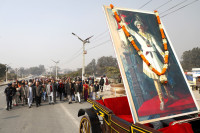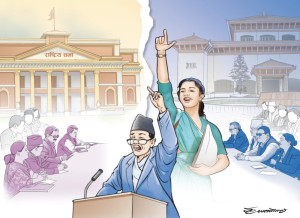Columns
The decline in Nepali public aesthetics
Why are we spending millions on view towers on hilltops, where the view is already worthwhile?
Amish Raj Mulmi
"Salute! To the God Ganesa!... On Thursday, the third day of the bright fortnight in the month of Kartika of Nepal Samvat 822 [1701 CE], the people...were sent to fell the trees in the jungle." Thus begins the Siddhagni Kotyahuti Devala Pratistha, a manuscript from the 18th century that details the construction of what is perhaps the apogee of Malla architecture in Nepal Valley: the Nyatapola Temple in Taumadhi Square, Bhaktapur.
This manuscript, one of the few of its kind, records the events over a period of 88 days during which the temple was built (and another 38 days before consecration) in much detail. Scholar Sukra Raj Shrestha, who has translated a portion of the manuscript that historian Dr Janak Lal Vaidya discovered, notes that the foundation was excavated in seven days, while the six plinths were raised in 31 days, and so on. One can get a sense of the immensity of the project while going over the translation.
On Sunday, the sixth of Krishna paksha of Phalgun 822 NS (1702 CE), the main entrance to the sanctum sanctorum, garbha griha, was raised. Thirty days later, the third storey got its windows. Twenty-eight days later, the jhingatis, or terracotta tiles, were laid on the topmost floor. Almost a month later, several pujas began to be conducted to ensure the temple could be consecrated. And six months later, in Ashadh 822 (1702), a repentance puja was conducted in memory of the "innumerable lives of unseen and seen animals that might have been killed knowingly or unknowingly" during the construction work.
When the Nyatapola was constructed, it was a time of relative stability in Nepal. The Mughals were the paramount power in the subcontinent, and in Nepal Valley, the three city-states had pretty much given up conquest, and instead their contest for power manifested itself through architectural marvels such as the Nyatapola or the Krishna Temple in Patan, or festivals such as the Kartik Naach. In effect, the three city-states could be termed "theatre states" in this period, where political power was exercised and emphasised through rituals or spectacles. This brought about an indigenous aesthetic form, wherein obligatory religious traditions co-existed with architectural forms that had already evolved over the years. Thus, a Nepali—or Newah, if you prefer—public aesthetic was born, which has, in turn, shaped how outsiders perceive and view Nepal even in the modern era.
Viewtower sans vision
The Sarangkot hilltop is perhaps one of Pokhara’s most visited tourist sites, with thousands gathering here to view the sun rise over the Annapurna range. A few weeks ago, when I was in Pokhara, I was surprised to see a structure under construction at the very summit, where once the Nepal Television tower was the only structure. It turns out that Sarangkot will soon get its own version of that perennial favourite of the new Nepali public aesthetic: a view tower.
A ‘five-year’ Sarangkot masterplan is in the works, worth Rs290 million. This will entail new temples and monasteries, a children’s park and a helipad. While the proclivity for holy sites at summits and hilltops has long been a feature of religion in general–and one can see new ones popping up in Nepal even today–this idea that Sarangkot, from where the view was already priceless, needs a view tower allegedly worth Rs10 million, is mind-boggling.
It's not just Sarangkot.
Earlier this week, I walked up to Dahachok, where Kalu Pande was cremated, and guess what I discovered: another view tower. Our love for view towers goes beyond hilltops. In Damak, a view tower estimated to cost Rs2.5 billion is among KP Sharma Oli’s pet projects. Limchubung Municipality in Udaypur is spending Rs10 million on a view tower, so is Sarlahi and Kailali. And in Bagmati province, Rs180 million is being spent on view towers—perhaps the one I saw at Dahachok was one among them. And not to forget the most infamous one of them all: the Kathmandu view tower, delayed beyond care after ‘milking’ local authorities for three years.
Who spends millions on a view tower on a hilltop? What sense does it make to climb a tower on top of a hill for a better view of the world? And can there be no better use of resources than building one in the first place?
View towers are but one symptom of the low regard we have for public aesthetics today. Nepal’s local leaders, replete with newfound resources and wealth, are desperate to show some progress. So they concoct all sorts of public projects that steer clear of creativity and any sense of artistic value. What else could explain a concrete pig built in Udayapur’s Belka Municipality at a cost of Rs6 million? Being Nepalis, there is now a debate on whether the abhorrent structure is a pig or the Varaha avatar of Vishnu. As a local artist told a newspaper, "Hindus worship it as Varaha, and Kirats cut it up and eat it!"
Let’s leave aside the poor porcine statue for a moment, and go to Mude Bazaar in Sankhuwasabha, where our local authorities have come up with a novel solution to counter climate change: a magnolia tree made out of concrete, built at a cost of Rs3.2 million! Mude is not the only one to come up with this solution. Concrete trees now grace Inaruwa, Dailekh, Tehrathum (which also has a concrete garlic sculpture in Lasune Bazaar), Beltar (Udayapur again!), Dhankuta and Sindhulimadhi.
Such ludicrous creativity seems to emanate from the same mindspace that gave birth to a view tower on a hilltop. This begs the question: What on earth happened to our sense of public aesthetic? What do authorities think when they give the go-ahead on such projects? And what can be done to arrest this dramatic slide in the Nepali aesthetic form? For all our talk of historical glory and golden eras, I’m quite certain that the Licchavis, Mallas, Shahs and Ranas would all be shaking their heads collectively in disgust if they looked down and saw a Nepali man clicking a selfie from a hilltop view tower.
I’m not one to romanticise the past. But when viewed against this transformation of the Nepali public aesthetic into a concretised view of the world, the Durbar Squares become a magnificent public space where culture, tradition and architectural skills all came together in synchronicity. The meticulous record-keeping of the construction of the Nyatapola tells us how important such architectural marvels were for the people of the time. But if the Nyatapola was built today, I’m certain it would resemble a view tower.




 17.91°C Kathmandu
17.91°C Kathmandu















